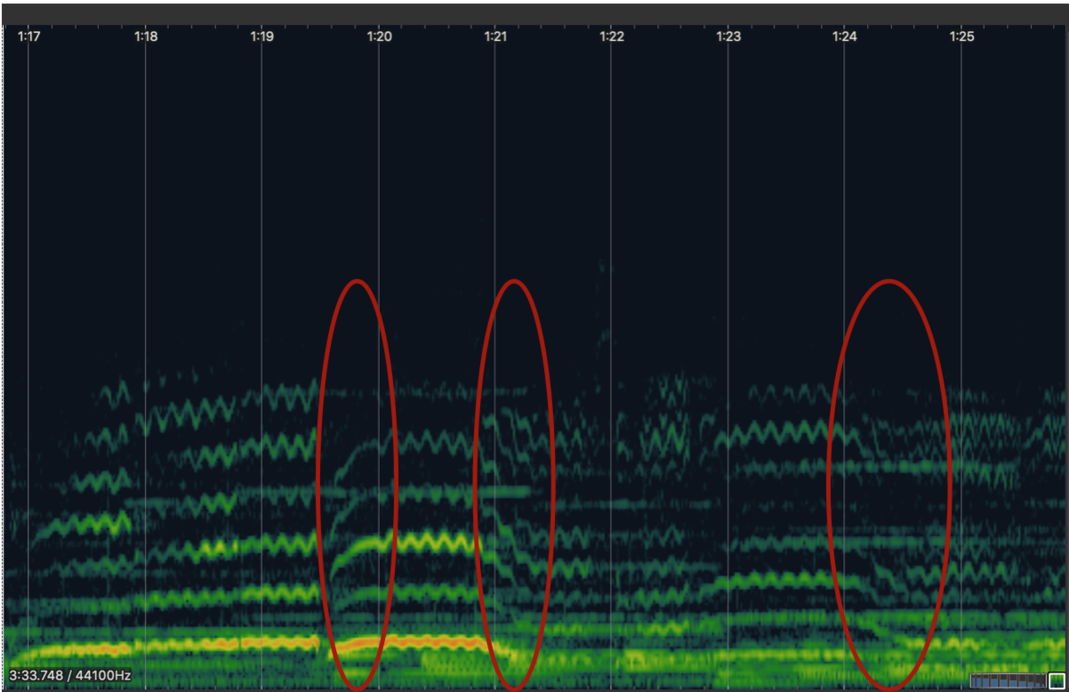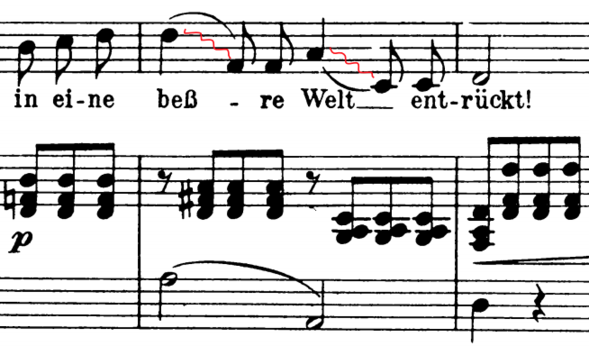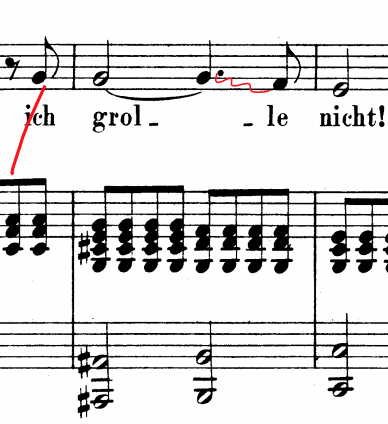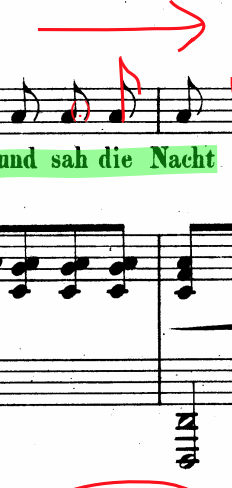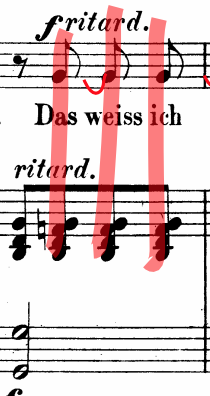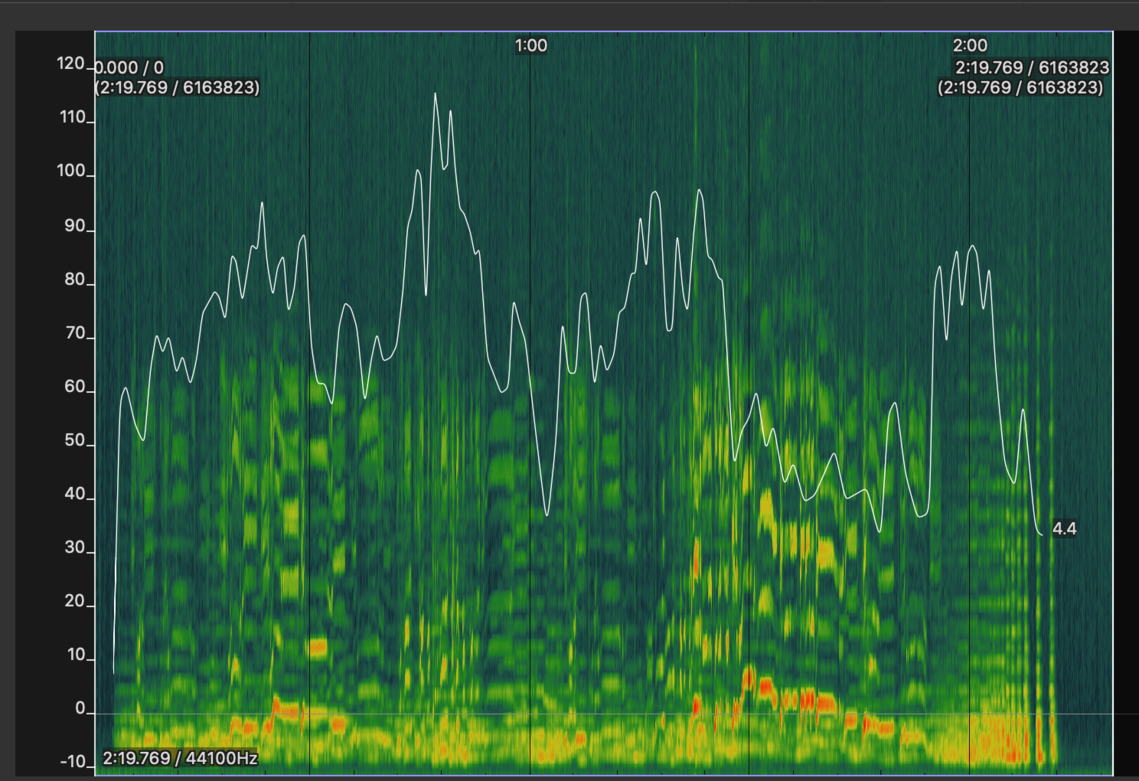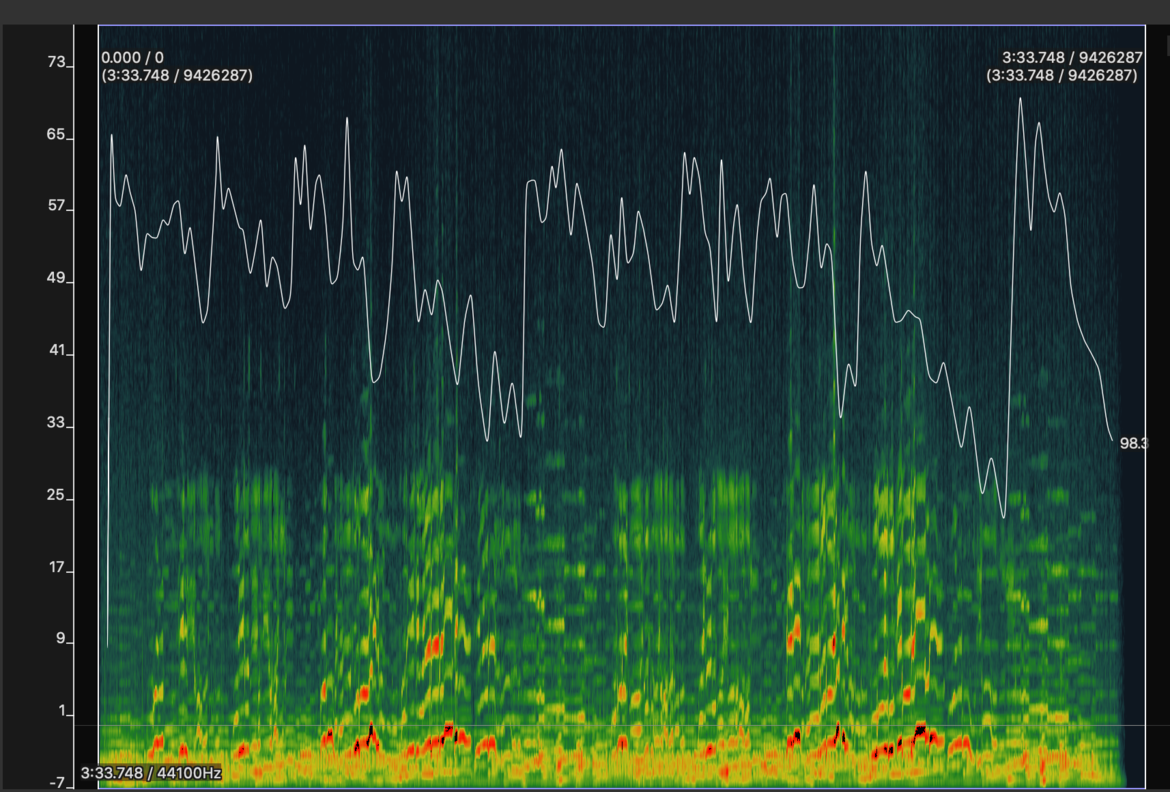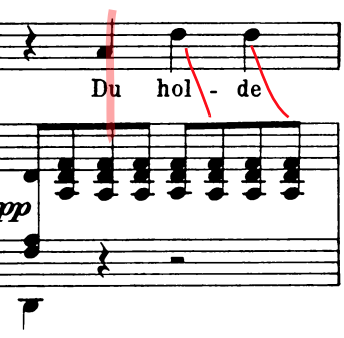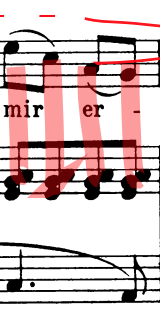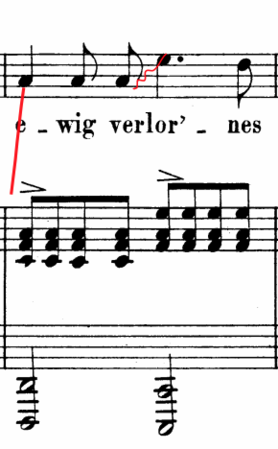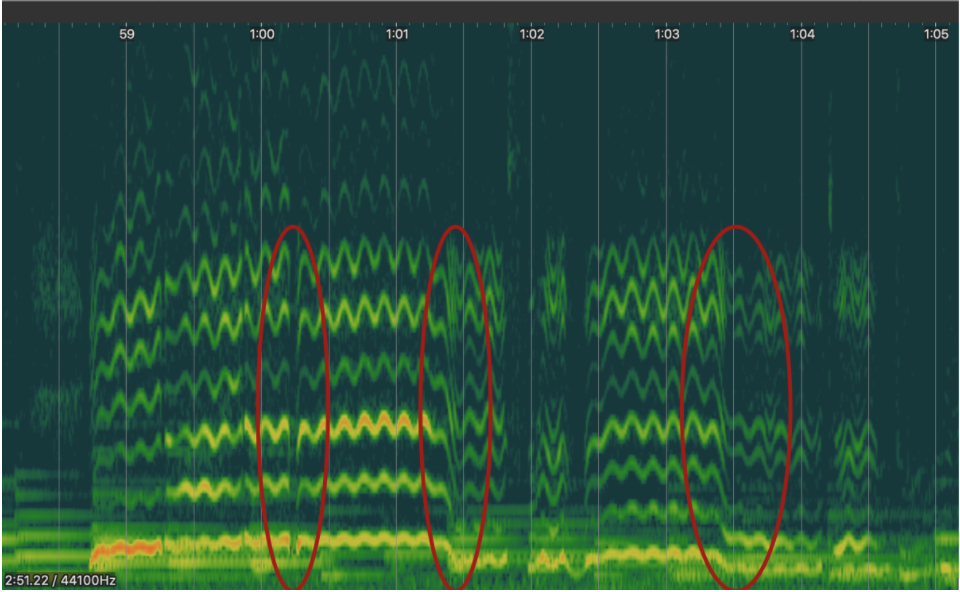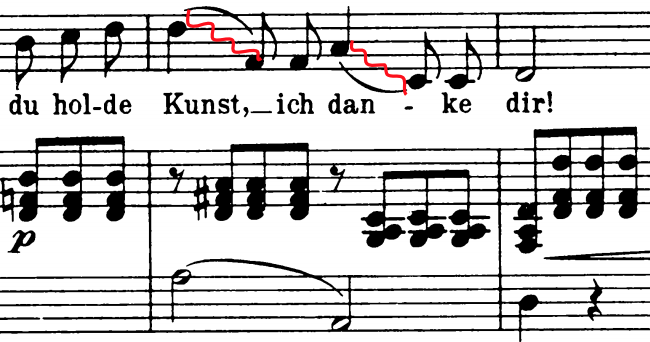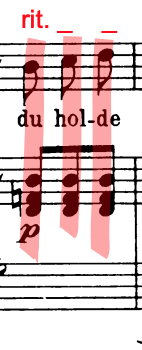The two spectrograms below show the difference in Lehmann’s portamento in bars 17-18 in the year of 1927 and 1947.
Figure 4.6 and 4.7 represent the places where Lehmann sings unsynchronized with the accompaniment, which often happens at the beginning of the phrase. In Figure 4.7, Lehmann anticipates her entrance and lingers almost a full half note longer on the word of ‘sweet’ (süßer).
Figure 4.10 above shows Lehmann’s portamento over a major second in bar 11. These descending portamenti appear five times, while the ascending portamento is only found once in bar 7. Figure 4.11 above shows how in bar 7 Lehmann sings ‘verlor-nes’ over an ascending portamento. This ascending portamento is of the portamento schnell type which sounds lighter compare to her descending portamento. Due to the quick shifting, this ascending portamento sounds more like the heavy scoop that connects the legato line.
-
Tempo and Rhythmic Flexibility
The tempo mark of this song is “nicht zu schnell” (not too fast), whereas Lehmann sings this song in 65bpm with a tendency to slow down. Lehmann’s tempo marking in the 1930 recording fits the recording made of her reciting the poem’s rhythmic pattern.
The spectrogram below shows the rhythmic and tempo flexibility used by Lehmann.
Figure 4.13 Robert Schumann’s Ich grolle nicht Piano accompaniment bar 1-4
Although the whole piano accompaniment of Ich grolle nicht shows steady rhythmic patterns (Figure 4.13), Lehmann sings Ich grolle nicht with unpredictable flexibility of rhythm and tempo (Figure 4.12).
The red circles in figures 4.3 and figures 4.4 indicate the length of her portamento. The slope shows that in the 1927 recording, Lehmann stretches the portamento especially the descending portamento, making these slides last longer by almost one second in duration. Meanwhile in the 1947 recording, the slope is sharper and indicates that Lehmann sang the portamento in a quicker tempo (using the device in significantly less than one second).
- Tempo and Rhythmic Flexibility
The white line in figure 4.5, indicates that her tempo fluctuates to an extreme degree. Lehmann generally used her tempo and dynamics similarly in the first and second strophe. She mapped her tempo clearly by using ritardando at end of every phrase (between bars 5-6, 8-9, 13-14, 16-18, 25-26, 33-34, 36-38).
Figure 4.8 and 4.9 show places where Lehmann sings vertically with the accompaniment (bar 33, 37) stressing the meaning of the text. She stresses the text “mir er-schloßen” which refers to ‘herself’ when heaven is revealed to her in better times (den Himmel beßrer Zeiten mir erschlossen). At the end of the song, Lehmann also emphasizes the words ‘you dear’ (du holde) by making a ritardando with the accompaniment and adding portamento to the words ‘art’ (Kunst) and ‘thanks’ (danke) as the final statement. She underlines this sentence as if encapsulating the essence of the whole song.
Ich grolle nicht by Robert Schumann (Lehmann, 1930)– Analysis
“... as in the final measures of Schumann’s Ich grolle nicht, she was so puissant, noble, and impassioned in her style, supplementing interpretation with such vocal resource and such a wealth of nuance, tone-color, and all-conquering sincerity, that if she had sung the song backward it would have been hard to keep cool and refuse to be moved by what she did....” - Olin Downes, The New York Times.1
Lehmann’s numerous performances on Ich grolle nicht over the years received a wide variety of reviews in the critical press. Musicologist Beaumont Glass notes: “Ich grolle nicht seems to arouse either very positive or very negative responses in her listeners.”2 The recording of Ich grolle nicht in 1931 was recorded by Odeon Parlophone Recording with an orchestra conducted by Frieder Weissmann. The recording was made in Germany.
In this song, Lehmann colors her expression by using her breath. She often interrupts the line and breath where there is no coma (,) in the lyrics. In bars 27-29, she cuts the phrase by breathing abruptly between every one to three words, as if she is sobbing during her singing. Her breathing captures her crying and an explosive emotionalism.
Below are the breath marks that illustrate Lehmann’s 1931 recording:
Ich grolle nicht, √ und wenn das Herz auch bricht, √
Ewig verlor’nes Lieb! √ Ewig verlor’nes Lieb! √
Ich grolle nicht, √ Ich grolle nicht, √
Wie du auch strahlst √ in Diamantenpracht, √
Es fällt kein Strahl √ in deines Herzens Nacht. √
Das weiss ich längst. √
Ich grolle nicht, √ und wenn das Herz auch bricht, √
Ich sah dich ja im Traume, √
Und sah die Nacht √ in deines Herzens Raume, √
Und sah die Schlang’ √, die dir √ am Herzen √ frisst, √
Ich sah, mein Lieb, √ wie sehr du √ elend bist. √
Ich grolle nicht. √ Ich grolle nicht.
-
Vibrato and Voice Timbre
Lehmann starts her 1st verse and 2nd verse “Ich grolle nicht” in bar 1 and bar 19 with chest voice. She emphasizes the entirety of the word “grolle” (grudge) by stressing the consonant ‘gr’. In bars 23-29 Lehmann creates a bright color that creates different nuances from the previous verse. In these bars, the bright color sounds like a representation of her dreams and memory of her lover. Lehmann carries all of the long notes with a stable vibrato.
Musicologist Beaumont Glass, explained her interpretation for this climactic phrase in bars 27-29 as follows:
She delivered it with enormous emotional intensity, building to a shattering climax on the word elend in the phrase, “Ich sah, mein Lieb, wie sehr du elend bist,” achieved technically through an immense crescendo (starting after the high notes), combined with a devastatingly effective, almost physically dangerous glottal attack on elend and a daringly, controversially broad ritardando.3
-
Portamento
Lehmann frequently stretches out her portamento over small intervals for example in bars 9, 11, 28, 29 and 30.
Figure 4.12 Spectrogram Robert Schumann’s Ich grolle nicht (Lehmann, 1930) tempo (bpm) based on duration since previous beat.
Figure 4.14 Robert Schumann’s Ich grolle nicht (Lehmann, 1930) Spectrogram bar 12-16
The fluctuating tempo is shown in figure 4.14. The spectrogram in bar 12-16 shows how the average tempo of around 68 bpm accelerates to 118 bpm. This faster tempo appears when in the lyrics, the protagonist speaks directly to her lover: ‘Wie du auch strahlst in Diamantenpracht, es fällt kein Strahl in deines Herzens Nacht’ (how you gleam in diamond splendour, no ray falls in the night of your heart.)
Figure 4.18 Ich grolle nicht bar 26 Figure 4.19 Ich grolle nicht bar 31
Figure 4.18 and figure 4.19 show where Lehmann makes additional ritardando not notated in the score. In bar 31, Lehmann sings ‘ich grolle’ in quartet notes as a final statement ‘I bear no grudge’ along with a portamento langsam at the syllable ‘le’.
My analyses of Lehmann’s recordings of An die Musik and Ich grolle nicht demonstrates that her pre-war German lied singing was based on a great deal of tempo flexibility, large amounts of unnotated slowing, heavy downwards portamento and a continuous vibrato and seamless legato.
In the next section, I will draw a contrast with the pre-war style discussed above by discussing acceptable uses of tempo flexibility and tone color in contemporary mainstream performance practice for these songs as taught to me. After this, I will discuss my re-enactments of Lehmann’s recording and the extrapolation from her style I engaged in to record Schubert’s Du bist die Ruh.
An die Musik – Mainstream Performance Practice by Pianist C
Pianist C explained that the tempo marking in An die Musik is Mäßig. This tempo indication often appears in many of Schubert’s pieces for example in Winterreise: Gute Nacht, Der Lindenbaum, and Rast. Pianist C argued that Mäßig represents andante. Since An die Musik is written in alla breve and not in 4/4, therefore the tempo that Lehmann takes is too slow. Instead of being sung in a mode of adoration, An die Musik should be sung in an optimistic manner in which the simplicity can still be felt by keeping this quicker tempo with less rubato.
Pianist C prefers that I not use any portamento at all although there are slurs written in bars 5, 12, 18, 25, 32, and 38. The slur functions only to glue the notes and should be sung quickly without any intermediate sound with a modern sense of legato. The reason for not singing the slur as portamento, pianist C argues is because portamento belongs to the later stage of romanticism, whereas Schubert was still in the transition era between the classical and early romantic period. Therefore, the strict classical manner should still be perceptible throughout the performance.
Ich grolle nicht – Mainstream Performance Practice by Pianist C
Pianist C explained the right hand in the piano represents the grudge that keeps chasing the person although the title is “I bear no grudge” (Ich grolle nicht). The grudge is always haunting the person; so, the tempo must be kept throughout. Pianist C disagreed with using the strong color of the chest voice in bars 1-2 as Lehmann did, because the text is ‘I bear no grudge’ therefore singer should sing the phrase in a lyrical and less robust manner. The strong chest voice color would be misinterpreted as ‘bearing the grudge’ instead of ‘bearing no grudge’.
Pianist C explained that the tempo should only be slowed when ritardando is written in the score, bars 28-29. In the next bar, bar 30-31 when the words “Ich grolle nicht” return, the ritardando should not be continued and the a tempo should be resumed naturally because Schumann was not in the habit of writing a tempo after a ritardando. Pianist C took the general tempo at a similar speed to the performance of post-war singer Fritz Wunderlich (1930-1966) and modern singer Jonas Kaufmann (10 July 1969).
CHAPTER V: LEHMANN'S MUSICAL ANALYSIS AND
MAINSTREAM PERFORMANCE STYLE (MSP) ANALYSIS
An die Musik by Franz Schubert (Lehmann, 1927) - Analysis
Lehmann perceived this music as a prayer, describing a deep appreciation of art.4 Her 1927 and 1947 recordings of Schubert’s An die Musik demonstrated marked differences. The 1927 recording was recorded by Odeon Parlophone Recording, accompanied by Berline State Opera Orchestra, and conducted by Manfred Gurlitt. The recording was taken place in Germany.
An die Musik consist of two strophes which poem was written by Franz von Schober. In general Lehmann breathe where there is a comma (,) in the text, but there are some other places in the middle of the phrase where she breathe to convey the meaning of the following lyrics. Below are the breath marks that illustrate Lehmann’s 1927 recording:
Du holde Kunst, √ in wieviel grauen Stunden, √
Wo mich des Lebens √ wilder Kreis umstrickt, √
Hast du mein Herz √ zu warmer Lieb entzunden, √
Hast mich √ in eine bessre Welt √ entrückt! √
Oft hat ein Seufzer, √ deiner Harf entflossen, √
Ein süsser, √ heiliger Akkord von dir √
Den Himmel √ bessrer Zeiten √ mir erschlossen, √
Du holde Kunst, √ ich danke dir dafür!
-
Vibrato and voice timbre
On Lehmann’s early recordings, the recording horn does not seem to capture her vibrato in as much detail as on later recordings. These early acoustic recordings do not represent her voice as well as the later recordings because they also do not capture the depth and spectrum of her voice. The recording of An die Musik in 1951 in her farewell recital captures her vibrato in better quality. Nonetheless, in this An die Musik 1927, we can still hear the stability of her vibrato and the different voice colorings that she makes.
Lehmann used her chest voice in a very high range from C#4 until F#4 while post-war sopranos oftentimes use a mixed chest voice and middle voice between D#4 – E4. Lehmann demonstrates an extreme change of vocal color between the chest and middle voice, which sounds like a deliberate choice and not a lack of technique in covering her passaggio. Her passaggio technique is flawlessly demonstrated in her use of the portamento langsam in bar 18 (figure 4.1) and bar 38 (figure 4.2) where she adds middle voice into the chest voice.
-
Portamento
There is a noticeable reduction in the use of portamento in Lehmann's post-war recordings.5 In my analysis of An die Musik, in 1927, Lehmann uses portamento langsam (PL) in bar 17-18 and bar 37-38. However, in the same bars in 1947 Lehmann uses a faster portamento schnell (PS) in which her portamento sounds lighter and less audible.
Figure 4.5 Spectrogram of Franz Schubert’s An die Musik (Lehmann, 1927) tempo (bpm) based on duration since previous beat.
